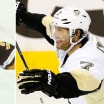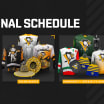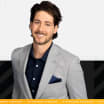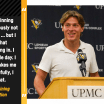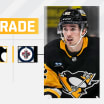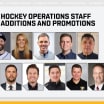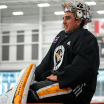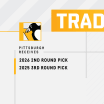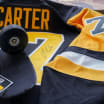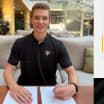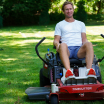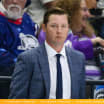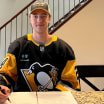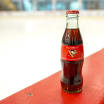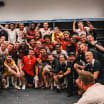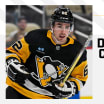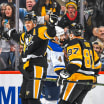Alex Trinca arrives at the UPMC Lemieux Sports Complex in Cranberry in late February. Inside the weight training room hangs a clock. In bright red colors reads: 8:02.
Trinca sets his belongings down inside his office, and he has his first priority of the day.
"Coffee," said the Penguins' strength and conditioning coach.
Day in the Life: Strength and conditioning staff
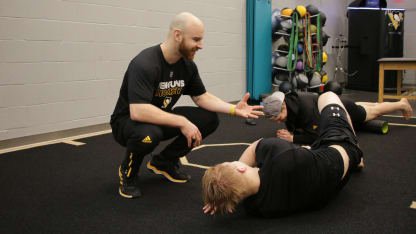
With a fresh brew in hand, Trinca's next order of business is working with any of the team's injured players to get them ready for their on-ice session. On this Tuesday morning, Patric Hornqvist makes his way into the weight room.
Hornqvist has been rehabbing through a lower-body injury for the past two-plus weeks. His progress has brought him to the point of on-ice action, but not yet ready to return to team practice.
Trinca's job at the moment is to get Hornqvist ready to hit the ice with his teammates. A combination of mobility work and dynamic stretching gets Hornqvist's heart rate heightened and blood flowing.
Hornqvist jumps on the ice at 9 a.m. with a monitor strapped around his chest. Hornqvist runs through a litany of drills. All the while, Hornqvist's monitor is sending signals to a nearby computer. Trinca observes the screen, keeping track of Hornqvist's workload metrics.
The strength and conditioning staff utilizes various metric measurements to dictate a player's reconditioning. These metrics provide some guidance.
"You're good! That's it!" he shouts to let Hornqvist know he's reached his goal metric goal for the day.
"One more skill drill," Hornqvist requests.
Despite already hitting his target metric, sometimes the staff has to use their own intuition with regard to players.
"OK," Trinca relents. "But only one."
"There isn't one blanket way of doing things that works for everybody," Trinca would tell me later. "We have to adapt to the player based on several factors, how far along they are in their rehab, their genetics and even their style of play."
The strength and conditioning staff looks at performance like a soundboard mixer, always trying to increase or decrease a quality depending on the demands of the sport and the goals of the athletes.
There isn't a one-size-fits-all approach when it comes to training. The role of the strength and conditioning staff is to know each player and cater any program to their needs.
"We are there to provide insight and direction, but these guys know their bodies," said Trinca, who is in his third season with the Penguins. "(Assistant strength and conditioning coach) Alexi [Pianosi] and I try to have a good pulse when to push and when to pull. We take athlete feedback into account. We're talking to players daily on how they are feeling."
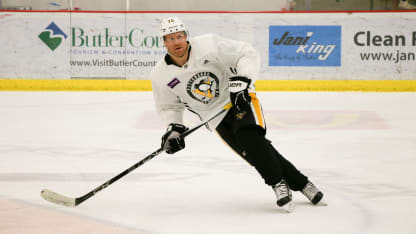
© Jonathan Kabana
As Hornqvist finishes his session on the ice, players begin gathering in the weight room. Tristan Jarry, Brian Dumoulin and Chad Ruhwedel have their eyes set on a television set that hangs above on the wall. The screen provides viewership of the Winter Olympics in South Korea.
The players glide their legs over foam rollers on the turf track while bantering about the competitions: bobsled and ski jumping. Next to the television is the clock: 10:02.
More players filter into the room. Some loosen up their limbs and joints with bands, sliders and balls. Soon enough the entire healthy squad of players are assembled.
As the red numbers flip to 10:20, Trinca yells: "Alright let's go!" The players begin with a light jog in a circle around the turf. The jog becomes a shuffle, becomes a side shuffle, becomes a side shuffle with crossover legs and so on.
"Line it up!" Trinca delivers. The players find a spot along the brick wall. Trinca gives instructions for the group's warmup. He starts with the name of the dynamic exercise, gives a visual demonstration and finishes with an explanation of what each move accomplishes.
Today's warmup utilizes an assortment of lower-body mobility drills and core stability. Every move is carefully thought out and planned.
"You want to target certain things that are based on your particular sport," Trinca said. "Lower-body range of motion tends to be an important aspect of skating so we spend a good amount of time in the gym trying to optimize it."
After completing the warmup, the team breaks up into two different groups. One group - which is notified by Trinca calling out their numbers - join assistant strength and conditioning coach Alexi Pianosi in an upstairs training area that overlooks the main space. Those seven players are chosen for more specific training work. The remaining group stays downstairs with Trinca.
Rack pull 2x7
SA DB row 2x8
Glute ham raise 2x6 (3 sec)
Lat sled push 2x20
Those exercises are written on a dry erase board in the middle of the weight area. Trinca explains each move, demonstrates the move and gives specific cues for the players to remember. Such as "retract your scapula" and "make sure you're squeezing the glutes."
The players disperse to one of the four areas to begin their lifting session. From there Trinca monitors their form, provides feedback and provides encouragement, while Pianosi does the same with his group.
"We've created a culture and expectation and the players follow. The athletes know what's expected of them in these workouts," Trinca said. "Players are professionals for a reason. We always try to promote autonomy and get players to understand their bodies better: what works for them; how they respond to certain stresses; what gets them into their unique 'sweet spot.'"
Today's workout is based on building strength for the posterior chain - back, glutes and hamstrings. The strength and conditioning staff are taking advantage of an unusual break in the schedule. The Penguins had a day off on Monday and won't play again until Friday.
"If we had played yesterday then we wouldn't be doing strength. We would have worked on more dynamic stretching and floor work," Trinca said.
Sweat is dripping from Carl Hagelin's forehead as he laterally pushes the heavy sled down the length of the turf. Kris Letang grimaces as he pulls a dumbbell from the ground up to his waist.
Hornqvist enters the weight room around 10:40 a.m. and positions himself on one of several stationary bikes, which are located near the entry/exit door. Once the players finish their lifts, they exit the weight room. Hornqvist raises his arm and gives a high-five to each guy as they exit.
As the room clears out, one player remains. Sidney Crosby grabs the sled rails, lowers his body and explodes the sled into forward motion. Trinca follows along his path to the end of the turf. Crosby reaches the end line and releases his grip. He walks past Hornqvist - gets his high-five - and exits.
The team has a scheduled practice at 11 a.m. With their workout complete, they escape to the locker room to put on their gear and hit the ice for practice.
"We prefer to have the guys lift before practice," Trinca said. "That way the guys are more ready, more alert, more dialed in for practice. We can also get an idea of their energy levels as they're getting on the ice."
While the healthy players are practicing on the ice, Hornqvist and Tom Kuhnhackl join Trinca and Pianosi. Each player is at different stages of recovery from an injury, though both would return within a week's time. The strength and conditioning staff - with input from the athletic training staff and team doctors - have scripted a specific program for each player to help them return.
Each strength and conditioning coach takes turns working with each guy, targeting certain areas, gaining feedback and adapting.
"Every exercise is like a tool in your toolbox," Trinca said. "Exercises are neither good nor bad. The important part of our jobs is to know which tool we need to pull out of our toolbox to accomplish whatever job we need to get done in the weight room."
Head athletic trainer Chris Stewart enters the room in regular intervals, also monitoring the two players' rehabs and gaining insight from Trinca and Pianosi. Penguins head coach Mike Sullivan makes an appearance and gathers information from Trinca.
"There's important communication with everyone," Trinca said. "It's not just the strength and conditioning staff, but the trainers, the doctors, the coaches. Everyone is involved. Everyone sees things from a different perspective.
"As with the athletes, the strength and conditioning staff meet daily with coaches, medical and performance staff to make sure we are finding a way to give the players exactly what they need to make them, and in turn, the team better on that given day."
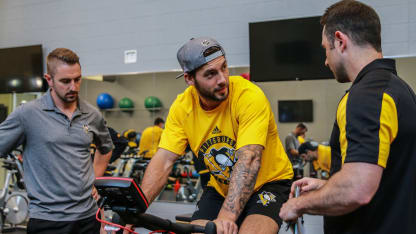
When designing a program for the players there is one question the S&C staff constantly ask themselves.
"How does what we do in the weight room translate into success on the ice?"
"That's great if a guy can power clean 200 pounds. But how does that help him on the ice?" Trinca queried. "People think strength training is bench press, squats, deadlifts and chin-ups. And it is those things, but everything we do is to improve on-ice performance. None of the athlete's end goals are related to anything in the weight room, like squatting 400 pounds."
The staff has a few philosophies on how to train specifically for a hockey player. Their strength days are split into lower- and upper-body. For lower-body, single-leg strength, power and mobility is important in hockey. The S&C coaches employ lots of techniques - like single-leg squats, reverse lunges, single-leg deadlifts - to help build these capacities.
For upper-body, the S&C coaches use a lot of drills to provide players with the ability to battle in corners, fend off checkers through the rush or clear out the front of the net. With hockey being a contact sport, upper-body mass and the ability to absorb a check properly is also important.
Beyond that, the staff does a lot of work on a player's core, mobility, flexibility and range of motion. As far as conditioning, a lot of that is accomplished on the ice.
"This team plays fast and practices fast," Trinca said. "We aren't a team that sits back and traps. We expend a lot of energy. So we practice with tempo so that will translate into the game. Our team is better conditioned and fit than most other teams, just because of the way that we practice."
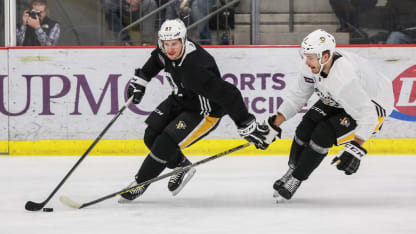
As the players finish practice they retreat back to the locker room. They remove their gear and then undergo their own individualized recovery regimen. Some will journey to the training room to receive treatment for injuries, bumps, bruises, etc. Others hit the cold tub, cryo chamber or sauna. Some will go back into the weight room to work with the S&C staff.
At this time, Trinca works with players on a 1-on-1 level to achieve whatever specific goal they may currently have. It could be stretching or mobility work or a specific body part improvement. It may even be just a conversation about nutrition or supplementation.
Those conversations tend to spill over into other communication. Trinca will meet with the rest of the Performance Staff (such as Pianosi, director of sports sciences Andy O'Brien and director of sports performance Curtis Bell). He often meets with the athletic trainers - such as Stewart - to recap the day's progress for certain players and make any necessary adjustments. Trinca will also check in with the coaching staff to keep them up-to-date on player progress.
The S&C coaches spend their days in constant communication, especially with the players, whom ask a lot of questions. Some are exercise specific - "What is this for?" "Am I doing this right?" "Should I put my hand higher or lower?" Other questions are less about the workout. Such as players asking the S&C staff general life questions and lighter banter.
For a strength and conditioning professional, sometimes those life questions are more important than giving exercise instructions. Which is something that Trinca learned on the job.
"When I studied to be a trainer I thought it was all about planning programs, tracking progress and teaching technique," he admitted. "So much of it is the psychology. It's so much the art of coaching, dealing with different people, different personalities and their different situations.
"I've grown so much as a coach since I was hired. I've learned when to give and take, when to push and pull. I've learned so much by watching Andy [O'Brien] and [Mike] Sullivan and how they relate to players, how they are upfront with them, how at times you need to be supportive and at times you need to be stern. As a strength and conditioning coach you need to be able to wear many hats and adapt your approach to the given situation and person you are trying to help."
The red numbers on the wall read 4:53 p.m. Trinca hoists his book bag over his shoulders and exits the practice facility. He'll do it all over again tomorrow, all with the same goal in mind.
"The strength and conditioning of a player is their foundation," Trinca said. "We're trying to build better athletes, better hockey players."

